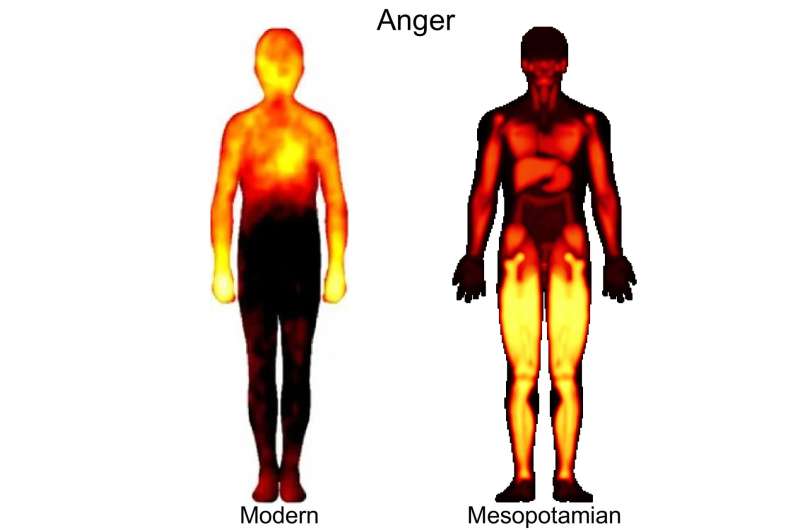Although we think of our emotions as being controlled by our brains, that does not mean they’re limited to our heads alone. From feeling heavy-hearted when sad to butterflies in our stomachs when we’re excited or nervous, it seems emotions can be felt throughout our bodies. But has this been the case for past cultures or were emotional experiences felt or expressed differently?
Previous research has shown that subjective bodily sensation during emotions is pretty consistent across cultures, which suggests there may be a shared biological root of emotions. This has been achieved through self-reporting methods – where participants provide information about themselves – which have shown that emotions evoked through things like mental imagery, videos, texts, and music are often mapped onto representations of the human body in similar ways.
But while self-reporting methods and laboratory studies may be useful for understanding the subjective feelings of different people from different cultures today, it is not capable of doing so for long-lost cultures or long-dead individuals. And yet there are ways to shine light on these experiences and to understand the inner lives of those lost to history.
In a new multidisciplinary study, researchers examined a large body of texts to see whether the ancient people in what was Mesopotamia (within modern Iraq), experienced emotions in their bodies. The team did so by analyzing a million words recorded on cuneiform tablets belonging to the ancient Akkadian language from 934-612 BCE.
“Even in ancient Mesopotamia, there was a rough understanding of anatomy, for example the importance of the heart, liver and lungs,” Professor Saana Svärd of the University of Helsinki, an Assyriologist who led the research project, explained in a statement.
So where did the ancient people living in this region feel their emotions? Well, interestingly their bodily experiences were quite similar, albeit with some intriguing differences from ours today. If you were someone living at the time, you might express feelings of happiness in words related to “open”, “shining”, or being “full”, but they were not related to the heart as we may say today. Instead, they were located in the liver.

Both modern and Mesopotamian people appear to feel love in similar ways, but there are some important differences.
“If you compare the ancient Mesopotamian bodily map of happiness with modern bodily maps, it is largely similar, with the exception of a notable glow in the liver”, Juha Lahnakoski, a cognitive neuroscientist and visiting researcher at Aalto University added.
Another contrasting point for emotional experiences related to those of anger and love. Someone asked to say where they feel anger today may indicate somewhere in their upper body or even their hands, but ancient Mesopotamians felt “heated”, “enraged”, or “angry” in their feet. Similarly, while love was expressed in ways that were much alike those of modern people, the Neo-Assyrians associated it more with their liver, heart, and even their knees.

For Mesopotamians, anger was often felt in the feet, unlike modern people who feel it more acutely in their upper bodies and in their hands.
“It remains to be seen whether we can say something in the future about what kind of emotional experiences are typical for humans in general and whether, for example, fear has always been felt in the same parts of the body. Also, we have to keep in mind that texts are texts and emotions are lived and experienced,” Svärd added.
Careful comparisons and deeper meanings
This is an important point to keep in mind. Although it is tempting to draw clear-cut comparisons between expressions today and those recorded in the past, we have to remember that the modern results come from self-reported bodily experiences, whereas the Mesopotamians’ are based on the interpretation of linguistic descriptions on their own.

For the Mesopotamians, happiness caused their livers to “light up” and be “Open”, which is not something we tend to feel these days.
Literacy rates were not like they are today. Being literate was significantly rarer and isolated to scribes and the very wealthy. This gives us a more limited number of people able to express themselves in writing, even though cuneiform clay tablets contain a wide selection of texts, including tax lists, sales documents, prayers, literature, early histories, and mathematics.
This study is the first to subject these Ancient Near Eastern written sources in this way – quantitively linking emotions to body parts. It has produced a methodology that may be useful for other languages and contexts as well.
“It could be a useful way to explore intercultural differences in the way we experience emotions,” Svärd added.
It is possible such future work will contribute to discussions around the universality of emotions.
The paper is published in iScience.
Source Link: Ancient Mesopotamians Felt Anger In Their Feet And Love In Their Knees, Tablets Reveal